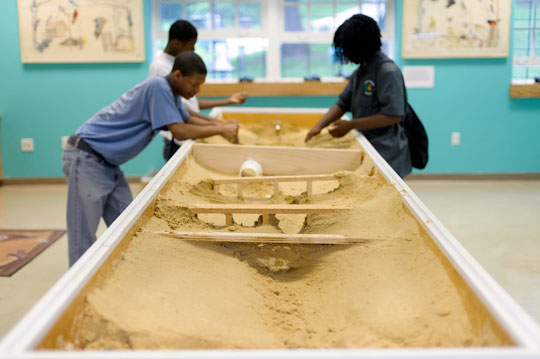 Water, gravity and sand combine to teach Philadelphians about stormwater runoff at the Cobbs Creek Environmental Educational Center. | Photo by Christian Hunold
Water, gravity and sand combine to teach Philadelphians about stormwater runoff at the Cobbs Creek Environmental Educational Center. | Photo by Christian Hunold
Cobbs Creek Environmental Education Center
opens a new gateway into the park with exhibit
|
For the longest time, it was a decrepit stables building in an infamous, crime-ridden park that neighbors were afraid to enter, alongside a creek that stank every time rains washed sewage into it. Then neighborhood activists led by Carole Williams-Green capped a 10-year organizing effort by converting the stables building into the Cobbs Creek Environmental Education Center in 2001, with classrooms for academic programming and meeting space for residents. |
Fairmount Park increased cleanup efforts in the Cobbs Creek park and developed programming to bring neighbors into the park, including a 5k race, now in its fourth year. (Full disclosure: I served on the board of the center from 2008 to 2010.) The Philadelphia Water Department has made Cobbs Creek a model neighborhood in its efforts to reduce pollution from stormwater runoff.
But something was missing. “[It was] such an amazing facility and a little slice of habitat in the city, but it wasn’t a visitor center,” says artist Josh Robeson, who taught a summer educational program there in 2009 with Tony Croasdale, now Visitor Services Manager at the Center.
“I wanted CCCEEC to have a space like Pennypack, Heinz and Schuylkill Center,” Croasdale says. On June 6, the Center opened the Carole Williams Green Exhibits Room, funded by the Philadelphia Water Department as part of its Green Cities, Clean Waters initiative, which aims to improve Philadelphia’s waterways by better managing stormwater runoff.
Visitors at the exhibit can read about the history of the watershed and the challenges it faces today, and then experiment with stormwater runoff on the 15-foot stream table in the center of the room. A “green wall” watered by rain captured from the center’s roof presents one solution.
Urban kids can enjoy nature as well as anyone else, but an introduction helps. Paintings by Robeson, guidebooks and iPads with nature apps are a start, but binoculars positioned for children to point out the window at the bird feeders offer connections.
According to Naturalist Program Coordinator Daniel Kobza, “As soon as kids come in the room, they immediately run to either the binoculars or the stream table. It’s hard to keep up with their questions, especially about all the birds they see and what their names are.”
Temple University Student and Senior Docent Tykee James says, “I like that we can walk in and there’s something to do—we can finally learn and teach within the center.”
The exhibit’s local wildlife diorama features male and female wood ducks, carved by Philadelphia sculptor Peter Morgan, and appear to float on the surface of Cobbs Creek. A snapping turtle lurks beneath them. But this diorama differs from the rest in that it features a large combined sewer outflow pipe.
This is Cobbs Creek, after all, a ribbon of natural beauty weaving through an urban landscape of rowhomes and asphalt streets. We can go there to enjoy the wood ducks and other wildlife—over 100 species of birds have been documented in the park, according to Croasdale—but we can’t ignore what washes into the creek from the city to either side.



I think you mean Philadelphia Parks & Recreation, not Fairmount Park.